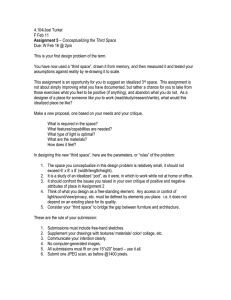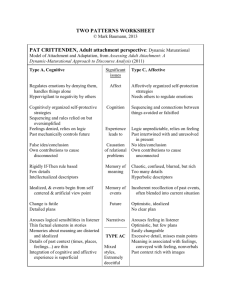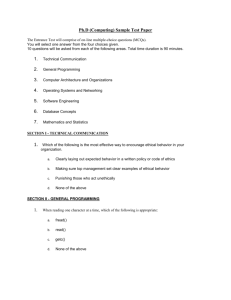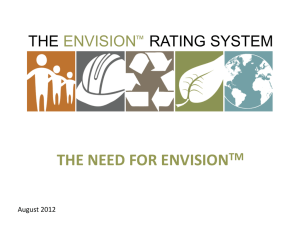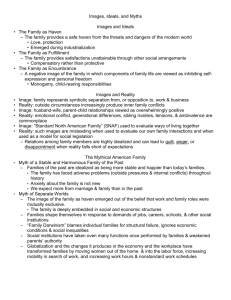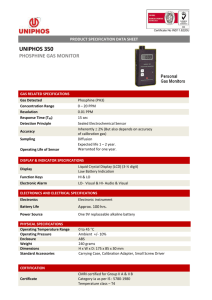Process Guide for Design Team Members to Facilitate a Stakeholder
advertisement
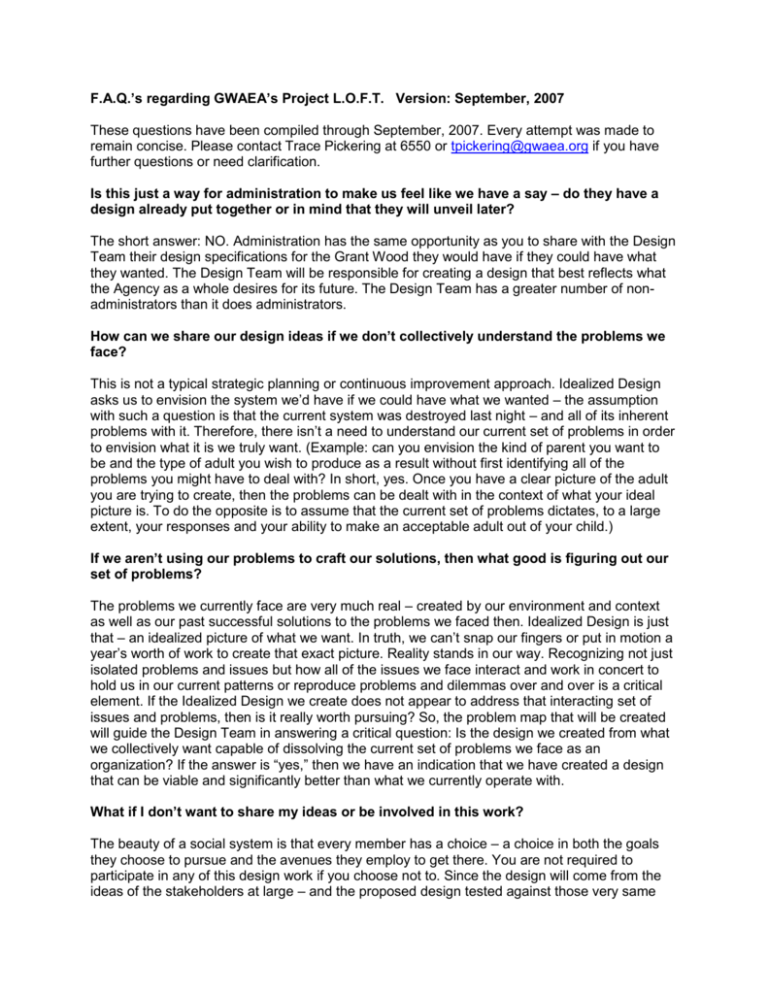
F.A.Q.’s regarding GWAEA’s Project L.O.F.T. Version: September, 2007 These questions have been compiled through September, 2007. Every attempt was made to remain concise. Please contact Trace Pickering at 6550 or tpickering@gwaea.org if you have further questions or need clarification. Is this just a way for administration to make us feel like we have a say – do they have a design already put together or in mind that they will unveil later? The short answer: NO. Administration has the same opportunity as you to share with the Design Team their design specifications for the Grant Wood they would have if they could have what they wanted. The Design Team will be responsible for creating a design that best reflects what the Agency as a whole desires for its future. The Design Team has a greater number of nonadministrators than it does administrators. How can we share our design ideas if we don’t collectively understand the problems we face? This is not a typical strategic planning or continuous improvement approach. Idealized Design asks us to envision the system we’d have if we could have what we wanted – the assumption with such a question is that the current system was destroyed last night – and all of its inherent problems with it. Therefore, there isn’t a need to understand our current set of problems in order to envision what it is we truly want. (Example: can you envision the kind of parent you want to be and the type of adult you wish to produce as a result without first identifying all of the problems you might have to deal with? In short, yes. Once you have a clear picture of the adult you are trying to create, then the problems can be dealt with in the context of what your ideal picture is. To do the opposite is to assume that the current set of problems dictates, to a large extent, your responses and your ability to make an acceptable adult out of your child.) If we aren’t using our problems to craft our solutions, then what good is figuring out our set of problems? The problems we currently face are very much real – created by our environment and context as well as our past successful solutions to the problems we faced then. Idealized Design is just that – an idealized picture of what we want. In truth, we can’t snap our fingers or put in motion a year’s worth of work to create that exact picture. Reality stands in our way. Recognizing not just isolated problems and issues but how all of the issues we face interact and work in concert to hold us in our current patterns or reproduce problems and dilemmas over and over is a critical element. If the Idealized Design we create does not appear to address that interacting set of issues and problems, then is it really worth pursuing? So, the problem map that will be created will guide the Design Team in answering a critical question: Is the design we created from what we collectively want capable of dissolving the current set of problems we face as an organization? If the answer is “yes,” then we have an indication that we have created a design that can be viable and significantly better than what we currently operate with. What if I don’t want to share my ideas or be involved in this work? The beauty of a social system is that every member has a choice – a choice in both the goals they choose to pursue and the avenues they employ to get there. You are not required to participate in any of this design work if you choose not to. Since the design will come from the ideas of the stakeholders at large – and the proposed design tested against those very same people – it may or may not include your vision. The only thing to remember: Plan or be planned for. Once a design is created and approved, will we implement the design next year or right away? The short answer: NO. Since the design is meant to be an Idealized picture of the future we hope to create, it is unreasonable and undoable in a short time frame. The important work after landing on a design we agree on is to decide how and where to move on it. Generally, the key or target elements of the new design are organized into three categories: 1. Green Light Items: those elements that we could implement almost right away with little additional time or resources. This could include things like: adjusting a form or procedure, reorganizing office space, etc. 2. Yellow Light Items: those elements that we could implement within 12 to 18 months with some planning and teamwork. This could include things like: changing committee structures, reorganizing work flow, etc. 3. Red Light Items: those elements that cannot currently be implemented in the current context and require extensive planning, lobbying, and/or influencing of forces outside Grant Wood. This could include things like: eliminating Level I special education designation and funding schools to ensure all children with Level I-or-less learning issues are receiving appropriate support; changing the reporting procedures and expectations for IEP’s, etc. Have we raised staff expectations to too high a level? The ability and desire to dream and to create is what separates mankind from the rest of the animal kingdom. The beauty of Interactive Design is that it encourages and enables that ability and desire. So long as we all understand that making a shared vision a reality will take time and effort there should be no fear of too high expectations. The alternative – shooting for something low enough to hit – seems to run counter to what truly great organizations and individuals seek. Those who will demand instant change or who look for any small example of not moving fast enough or far enough in our design may try to mock our attempts and cry out that we have raised their expectations too high. Remember the old saying, “It is better to have tried and failed than to not have tried at all.” Do we need a second-take from staff – asking for more global input? Yes. Staff have the ability to add their design specifications through Friday, October 12, 2007 by accessing the following link: http://www.aea10.k12.ia.us/cfapps/other/trace/loft.htm There were several questions along the same lines. They are all printed here with one response for the set: How do we open the redesign process completely when we are regulated by Iowa Code to perform certain functions and often within a defined process or standard developed by the Feds or the DE? We have approached this very “open-endedly” in designing our future. Much of the work we do may be non-negotiable in terms of why we are here in the first place. At what point do we say – there are some areas we really can’t touch? Do the requirements of an AEA impact our thinking and the design process? If so, how? The primary stages of a redesign process are purposefully conducted without constraint. Such a process allows people to dream and create truly what they would have if they could have what they wanted. Naturally, as the Design Team moves from an idealized design toward determining how to begin approximating towards it, it becomes necessary to identify and categorize the constraints we face so that we might deal with them effectively and appropriately. We are highly regulated and legislated – this is true. However, unconstrained thinking at the design stage allows us to capture our dreams and better understand the types of constraints we face. It also enables us to better understand how we can influence those things we cannot control and begin to push constraints in the direction we want them to go – particularly those constraints that we might have determined “unmovable” in planning methods that accept certain constraints as absolute. Remember – the concept of an AEA is relatively new in American educational history. This helps to remind us that there are few constraints that can’t be influenced – especially legislation. The important work after landing on a design we agree on is to decide how and where to move on it. Generally, the constraints we face in the new design are organized into three categories: 1. Green Light Items: those elements that we could implement almost right away with little additional time or resources. This could include things like: adjusting a form or procedure, reorganizing office space, etc. 2. Yellow Light Items: those elements that we could implement within 12 to 18 months with some planning and teamwork. This could include things like: changing committee structures, reorganizing work flow, etc. 3. Red Light Items: those elements that cannot currently be implemented in the current context and require extensive planning, lobbying, and/or influencing of forces outside Grant Wood. This could include things like: eliminating Level I special education designation and funding schools to ensure all children with Level I-or-less learning issues are receiving appropriate support; changing the reporting procedures and expectations for IEP’s, etc. How does all of this link to student learning? As an Agency, we are charged with effectively and efficiently working with districts to ensure success for all students. Our ability to impact student achievement is significantly affected (as it is with our schools) by the way in which we define our work (our functions) and how we choose to organize to get the work done (our structures and processes). Ensuring an effective set of functions, structures, and processes for our particular context is critical in order for us to impact and increase student learning results for our schools. How does an organization deal with self-interest as a challenge to changing structures and processes? This is a difficult and challenging issue. For a detailed explanation please refer to Jamshid Gharajedaghi’s Systems Thinking, 2nd Edition and read chapter 4. To summarize, in order to effectively manage a design based upon socio-cultural design, we will need to: Align the interest of our system members (those who have formed a voluntary association with GW through their acceptance of employment and mission and who did so to also seek a personal purpose) and generate excitement and commitment to the purpose of the whole and vice versa. Let empowerment happen by duplicating power, not abdicating it. Separate control from service and create a strong learning function. Prevent a win/lose struggle and dissolve paralyzing conflicts. (Gharajedaghi, pg 82). Will we, in our redesign, impact the actual work of people in school buildings? Early indications via our mess formulation and our lived experiences suggest that we are working at or near the capacity of our current organizational form. If this turns out to be the case, it would seem likely that design implications could impact the work at the building level. Whether or not that impact comes during the first approximation of the design or in latter ones is impossible to predict at this time – it all hinges upon the organization’s desire to and tolerance for change. How does our area-wide student achievement data inform our design? This is a component of our mess formulation – it helps us understand current state and to better uncover what is reducing, holding static, or improving student learning from a system’s perspective. Will we actually operationalize the “new system” – who is in charge? Operationalization of the system will commence with the first approximation which will likely emerge from the December 11, 2007 Design team meeting. Whether the first push towards the new design is a baby-step or a bound will be determined by the Design Team. Once determined, it becomes all of the members’ responsibility to help shepherd the design forward. Ultimately, it is our Board of Directors who will monitor our progress. Consistency of team involvement during a busy time of year – is everyone at the same level of understanding? Design team members agreed to participate in all of the meetings – that was a precondition of accepting the offer to join the team so involvement, while always a challenge given everyone’s responsibilities, has already been committed. No group can be at the same level of understanding at any given point. Our job, collectively, is to help each other in increasing our understanding each and every day – this process is no different. Members who continually question and seek answers and understanding will proceed to higher and higher levels of understanding at rates allowing all of us to benefit. Those who choose not to, won’t and no process or design can ensure that they do. How will the changes be communicated/accomplished when this work is finished? Initially, it will be the job of the Design Team and, as we begin to operationalize it – the management team. A process will be designed to ensure that successive approximations are planned and past efforts are evaluated – most likely at least annually by the Design Team. Could the major flaws be more taken for granted and less visible in this process than narrower, detailed concerns? This question is a difficult one to answer since the context is not provided – major flaws in our current design? In our context? Systems thinking teaches us that it is the major flaws taken for granted that create patterns in which problems recur over and over again. Both the “major flaws” and the narrow, detailed concerns must be addressed in a design and it’s approximation over time. A key question is: does the “major flaw” contribute to or co-produce the detailed concerns? If so, then detailed concerns are effects and not causes or, worse yet, those effects become causes of new concerns themselves. I have read through the many ideas/contributions by all stakeholders and wonder how this will be handled/used to inform the process and end design? The design specifications are the foundational elements that will inform a new design. It is in the set of design specifications where the answer to our “what we’d have if we could have what we wanted” question is answered. Prior to the October meetings, the design specifications will be sorted into three categories: statements of function (what it is the system would produce and for whom?); statements of structure (how people would be organized to deliver our functions), and; statements of processes (how we would conduct our work). From these three sets, the Design team will be able to develop the key themes and desires of the collective to use as criteria for designing an organization capable of meeting those desires.
